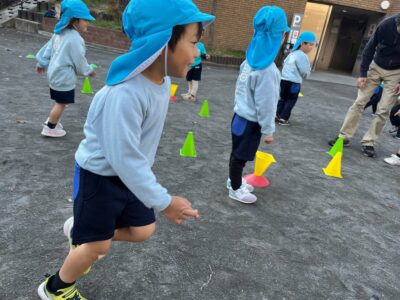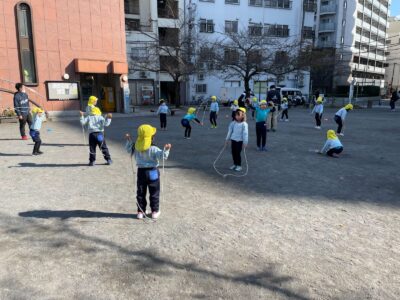Nov 18, Coordisports P.E. Report
Mr Shuhei comes to CGK Preschool every two weeks to lead his super fun PE lessons.
Each column will feature some insights or stories about physical development, reports for each PE lesson, and share some YouTube videos showing some physical activities that you can try at home with your child.
-
Expert Column
In my last column, I explained how balance is necessary for all physical activities. Balance is like the foundation for a house: like balance, the foundation ensures everything is standing. There is also the ability to react. In athletic events, children who can react quickly to the starting signal can run faster. Reaction is also divided into two categories: simple reaction ability and selective reaction ability. Simple reaction ability is the ability to measure how quickly one can react to cues. The brain issues commands to the body to move in response to sounds and movements it receives via hearing and vision. The commands are converted into electrical signals that pass through the nerves to move the body. The faster this flow is, the better the simple reaction ability. On the other hand, selective response ability requires a decision to be made by the brain. In soccer during penalties, the keeper responds to signals such as the trajectory of the ball to selectively respond and move in the right direction to make the save. The required reaction differs depending on the characteristics of the sport. In my next column, I will go through which reaction ability is required for which sport.
-
Jungle (3-year-old) Class Lesson Report

[Step-by-step tag]
Today’s PE was held in the park under fine weather. We (1) jumped over mini cones, (2) maneuvering around mini cones, and (3) tag. Tag is the familiar game of running away from the chaser. On top of that, we added various conditions to the game, such as freezing after getting tagged, increasing the number of chasers after getting tagged, and changing chasers after getting tagged. For Jungle’s age group, understanding rules to group games can be very difficult. Therefore, we played in the following order: (1) The game ends when the chaser, me to begin with, touches the children. Initially, the children develop an attitude of running away from the chaser to avoid being touched. (2) If you are touched by the chaser, you are frozen. But they can be unfrozen by a child who isn't frozen. This teaches the children that the game does not end when they are touched and that there is a fun aspect to running away again. (3) If a child is touched, the roles are swapped, and they become the new chaser. In the next PE lesson, (4) the children will learn that they will no longer be the chaser if the chaser touches them. By doing this step-by-step, even 3-year-olds can enjoy and understand the rules of tag. Please be aware of the step-by-step approach when playing tag with your child.
*No Video for this time -
Mountain (4-year-old) Class Lesson Report

[Be aware of our surroundings]
It was cold when we stopped, but the temperature was just right for exercise. We did (1) cross running and (2) tag game. Cross running is an exercise in which the children perpendicular to each other. If they do not watch out for each other, they will collide into each other, and it is dangerous. We talked about how to look out for each other to avoid collisions. Mountain class are gradually becoming able to do two or more things at the same time. In this lesson, they practiced their multitasking skulls by having them perform three actions at the same time: look around, run, and judge if there will be a collision. When you go to the park with your child, try to do multiple things with them at the same time, such as running and looking around.
*No Video for this time -
Sky (5-year-old) Class Lesson Report

[Trying new moves]
PE was held in the park under the sun, which made us sweat when we exercised and rested in the cool shade. (1) cross running, (2) short rope, and (3) sports tag. Cross running is an exercise in which children's running paths are set up so that they cross each other, making sure not to collide. It is necessary for the children to adjust their running speed by looking around to avoid each other. In short jump rope, a series of forward to backward jumps were performed. The front and back jumps are connected by not stopping the movement of the rope. Even children who could do the front and back jumps by themselves struggled to link the techniques. They tried again and again declaring that it was hard. But they did not give up and tried again and again. The trick is to turn the jump rope once beside the body. Please watch the video and try it at home. Sports tag is an inter-team game of treasure-collecting. The team that takes the treasure in the opponent's territory first gets points. Older children are at an age when they can strategise with their teammates. Weather permitting will continue to PE at the park in the future. Please ask your children what they think.[Video] Front jump to back jump|The point is to turn the rope sideways.
coordisports Inc.
Shuhei Otsuka
coordisports
■Books
動画でわかる! 小学校体育 コーディネーション運動50 (体育科授業サポートBOOKS)
1年間まるっとおまかせ! 小学1・2年担任のための学級あそび大事典 (共著)
1年間まるっとおまかせ! 小学3・4年担任のための学級あそび大事典 (共著)
1年間まるっとおまかせ! 小学5・6年担任のための学級あそび大事典 (共著)






















